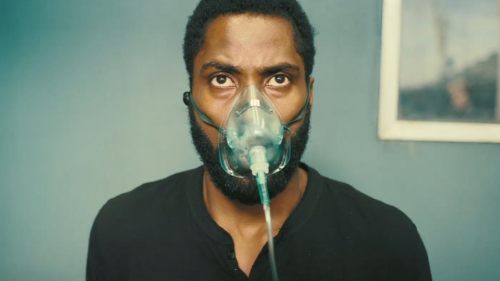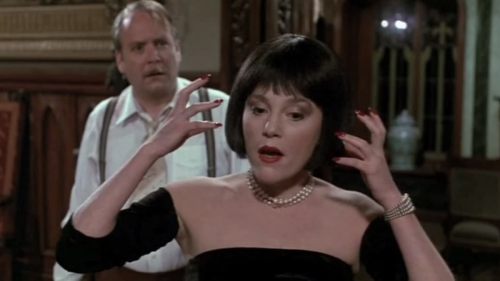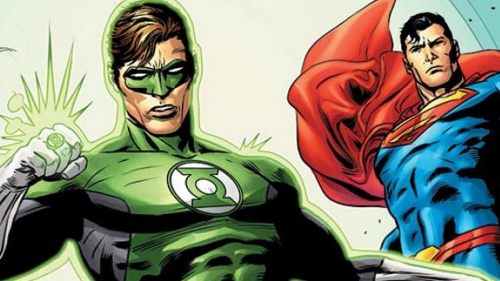Movie Review: GREEN LANTERN’s Light Is Snuffed Out By Martin Campbell
They had all the elements. Ryan Reynolds makes a fine (modern age) Hal Jordan. The expansive space opera mythology of the Green Lantern Corps is intact. And even the much-maligned digital costumes don’t look so bad after a while. And yet Green Lantern is still bad.
It’s not horrible bad, but there is a point where you’re just getting into semantics. I think there’s enough good stuff in Green Lantern to keep the movie watchable, and some stuff that’s even quite enjoyable, but the film whiffs it big time in the moments that count most - in the drama and the characters. And I can’t help but feel that the problem lies partially in a dim-witted script and a director who just has no affinity for the material.
One of the biggest problems with Green Lantern is that it’s not particularly engaging. The big Green Lantern universe is explained - the Guardians, Oa, the green energy of willpower, the yellow energy of fear, the Corps, hundreds of alien species - but it remains inert on screen. Green Lantern is a pretty standard 1980s-style superhero movie with some fancy scifi trappings that don’t amount to much beyond fan service. It’s the sort of movie where we’re told that the Guardians are ancient, powerful immortals… and that’s it. There’s little else to them, and they do little else. We see the Corps in big crowd shots, and we’re told what the Corps is and what they can do, but we only get to see them doing anything once - and in that scene a whole bunch of them are killed off by the evil Parallax, which sort of undermines everything we’re told.
Some people don’t really understand what ‘show, don’t tell’ means when it comes to movies, and among those people we can count director Martin Campbell and the team of writers on Green Lantern. The film opens with some space CGI and Geoffrey Rush narrating a brief history of the Guardians and the Corps; that’s not violating the ‘show, don’t tell’ rule, even though I can think of more cinematic ways to get that message across. The ‘show, don’t tell’ rule is more about your characters. When you’re told that the Green Lantern Corps is this powerful peacekeeping force… well, that doesn’t match up to being SHOWN that they’re a powerful peacekeeping force.
Same goes for Hal Jordan. The movie gets it right in the beginning, showing us Hal as a hotshot pilot who is willing to destroy his own plane to win. That’s a fine scene because it SHOWS us Hal’s character, and it SHOWS us why he’s a maverick, why he’s a courageous man, why he’s a loose cannon. It even SHOWS, in flashback, what Hal’s weakness is, a memory of his own hot shot pilot daddy’s death.
But later the movie decides that showing any aspect of Green Lantern’s arc is too time consuming, so it just tells us everything. For reasons that I believe make no in-film sense (from a character perspective or even from a plot perspective), Hal quits the Green Lantern Corps as soon as he is inducted, and returns to Earth where he gets a whole series of pep talks about how important he is and how important courage - not the absence of fear, but the ability to overcome fear - is. And this is terrible. It’s character killing, it’s plot killing. It’s telling and not showing. Instead of having Hal Jordan be forced to take action and overcome his own fears and learn a lesson, the script has Blake Lively’s Carol Ferris sit him down and just tell him this.
That’s boring. And it’s bad drama. And it’s indicative of the bad drama that sinks the whole film. Again and again we have scenes like this, including ones where important character relationships are simply spoken aloud instead of ever being shown in action. Did you know that villain Hector Hammond was in love with Carol Ferris? Well, the movie gives almost no indication of this until Hammond reveals it - and his lifelong relationship with Carol and Hal - in a speech. There couldn’t have been a scene where we saw these three characters interacting in the movie earlier? (the only scene where they interact is after Hammond has begun mutating into a character who, Ryan Turek of Shock Til You Drop notes, looks like Rubber Johnny. It’s not a scene where a naturalistic understanding of these characters’ histories can happen)
In fact I’d argue that the only character in the film who is properly shown is Parallax, since we see it destroy a couple of planets and kill a handful of Green Lanterns (all of whom we’re taking on drill sergeant Sinestro’s word as the best of the Corps). It’s too bad that Parallax is a stupid looking cloud with a giant head in the middle of it, but I’ll honestly take the bad design over the utter lack of characterization that Kilowog and Tomar Re get. And no, saying ‘poozer’ three times does not characterize Kilowog.
There is good stuff in here. I like Oa; there’s a trippy element to the environment that mitigates the immense fakiness of the CGI. The way the CGI is used in these scenes reminded me a lot of how Harryhausen used stop motion animation - it always looked heightened and odd, and was never photoreal, but was always evocative. There are some weirdly goontastic flying FX shots on Earth (Hal Jordan appears to be the same size always, no matter his spacial relation to the camera), but otherwise I enjoyed the FX. As I said even the suits are fine, although I still don’t understand why they need to be CGI. There are pulses of energy in the suit’s linework, and the Corps symbol is in a bed of swirly energy, but those effects could have been added to practical suits. Reviews shouldn’t be about budgets and box office, but it’s hard to imagine why the millions of extra dollars in costs incurred by the suits needed to be incurred.
And the action is great. The film is light on action, but when Hal finally takes on Parallax his constructs are fun and goofy and thrilling. The space section of the battle - yes, they fight in space! - is exciting. This is the film’s best stuff, and it’s smartly packed at the end so that audiences walking out might remain on a high and tell their friends to go see the film. But if audiences are responding to anything at the end it’s simply the FX, since the characters and the drama leading up to it are flat.
Which is too bad because the film has a fine cast. Reynolds works as Hal Jordan, and I would have liked to see him have the same arc (cocky -> faithless -> a proper level of self-confidence) with a script that allowed him to actually do stuff. Blake Lively is fine as Carol Ferris, although she only exists to berate Hal Jordan and then give him pep talks. Mark Strong is awesome as Sinestro, but he’s another character who is mostly relegated to talking. Thankfully his talking - a series of speeches to the Corps and the Guardians - is excellent. To be fair, Sinestro does get a little bit of ring slinging time during Hal Jordan’s eleven minutes of training, but seeing him overpower a guy who just got his ring doesn’t cement Sinestro’s status as much of a warrior.
The best actor in the film is Peter Sarsgaard, though. He’s enjoyably broad as Hector Hammond, a weaselly scientist who gets infected with a piece of Parallax and becomes a huge craniumed third act distraction*. Sarsgaard just tears into the material with gusto, making every one of his scenes a laugh out loud delight. The film needed more moments like that.
The film also needed a director who got the material. Campbell seems uncomfortable merging Oa and Earth, and he makes the same dual environment mistakes that were made in Thor, except that Green Lantern is more skewed to Earth than I had hoped. Campbell seems to be approaching everything from an almost ironic distance, and while the movie pays lip service to the Corps as a military or law enforcement group, there’s none of that in the film. The Corps disappoints in every way except visually.
It’s worth noting that Green Lantern has possibly the worst score of any movie in recent memory. If the weird flatness of the film didn’t already make me think of an 80s film, surely James Newton Howard’s endless synth and guitar solo score would have gotten me right in that mindset. Obviously Top Gun was some sort of a touchstone for the jet pilot bits in the film, but why did it have to be a touchstone for the score as well?
I like the players in Green Lantern. I thought the FX were great. I like that the big mythology was ported over, even though it lays lifeless on the screen. There was a lot of potential in Green Lantern, almost all of it squandered. At this point the best I can hope for is that the movie makes enough to warrant a sequel and somebody else can come in and make a good Green Lantern film using the excellent existing elements.
* The structure of this film is a disaster. Hammond should have become a major menace in act two, when Hal Jordan has his crisis of faith. This would allow Hal to overcome his fear to stop an immediate menace and give Hammond an actual point in the film. Instead the movie has Hammond subtly make a helicopter almost crash, and Hal doesn’t even break a sweat saving it. It’s not a real confidence-boosting victory.



